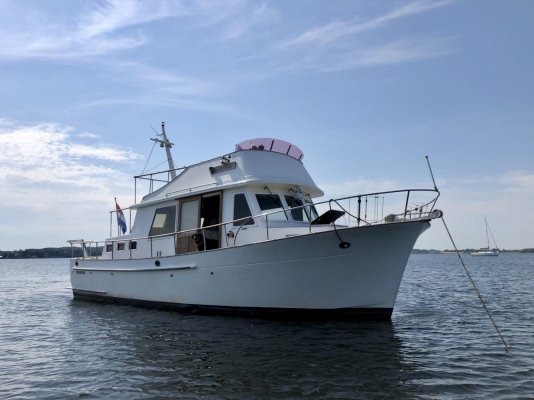Congratulations. I owned a pair of those 120 Lehmans, as they are commonly referred to, for a long time, and I think they are great engines for trawlers. They are easily maintained by people with a minimum of mechanical background but a willingness to learn a bit.
I assume you have the Borg-Warner Velvet Drive transmissions too. Check the specs on them, and you may well find their reduction ratios are different and that your props are are pitched one inch or so differently because of that. That's because BW only made one ring gear back in the day, and they added a pinion gear to make the thing turn on the reverse direction for one side. See if the return transmission oil line from the port engine's transmission cooler comes down to dump directly into the top of the tranny while the other one goes into the side. That was done to allow better cooling for the port side with its extra pinion. But I digress....
I still have my Excel spreadsheet I generated for maintenance schedules. If you want it, PM me. All you need do is insert your engine hours and the date at the top of the page plus the last actual date or hours for completion of each line item, and the auto calculations will tell you what is due.
If you have no knowledge of when these things were done, do them now:
Change the injector pump sump oil, if you have the Simms pump (Simms printed on side of it)
Change the coolant and while doing so change the vee-belt and place a second replacement belt inside loop of the hose which had to be removed to put the new one on. Then zip tie the second belt to the hose. Now when/if the belt in use breaks, there is no need to pull the hose, dumping the coolant into the bilge, to replace it.
Remove and test the oil cooler, heat exchanger, and transmission oil cooler while changing the coolant.
Retorque the head bolts. Check the flatness of the valve cover between the eight screw holes with a steel ruler while retorquing the head bolts because people often overtighten them beyond the 22-INCH pounds specified trying to stop small leaks from the joint. Get a new gasket if this is the case and properly torque the screws after carefully pounding flat the dimpled screw holes.
After retorquing the head bolts, check the valve clearances (lash) per the manual. If you do not have the manual, ask me for it in your PM.
Change the oil.
The exhaust elbows are usually good for five years or so. Look for any evidence of rusty water drips on the underside of the elbow falling on the heart exchanger. Time to replace if so. Drain coolant first. Be sure to put anti-seize on the bolts when you replace them.
One of your engines probably has a set of hoses leading over to the water heater. I added a shutoff valve on the engine where each lead off from it in case there was ever a pinhole in the water heater tubes or a broken hose.
If you do not already have the modified expansion tank filler neck with the associated plastic coolant recovery bottle, be sure to contact American Diesel in Kilmarnock, VA for the kits with accompanying instructions. Makes a world of difference in coolant management and potential troubleshooting.
Change the tranny oil.
Strap a Borel exhaust heat alarm or something like it on your exhausts (generator too). Some prefer flow alarms in the seawater circuit, and that's OK instead of or even in addition to the exhaust heat alarm.
If you have Racor primary filters, consider adding the Parker (makers of Racor) water alarms to them - nothing worse for injectors than a slug of water.
The original on-engine, secondary, fuel filters were a pain to deal with, and Parker makes a 1N-CAV kit replacing the originals with a spin-on type filter.
Once you get all these items covered or accounted for, you should be good to go for worry-free cruising, and there are doubtless about a hundred other things rattling around in my brain like never run both engines from the same fuel source.



